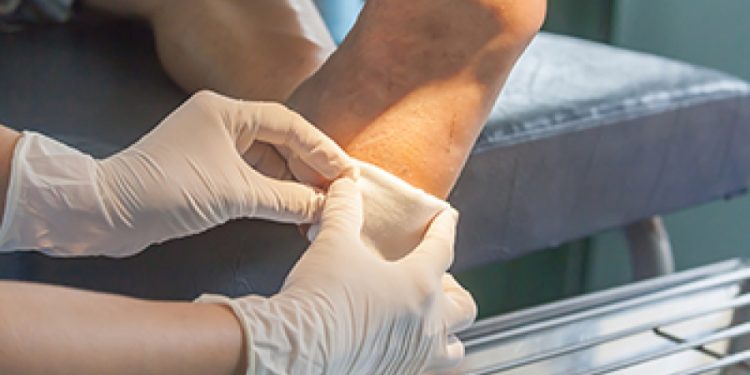Small shifts in how a foot looks or feels can mean much more than a simple bruise or sore spot. For people under foot wound care, early reporting of certain changes can help prevent serious complications. A foot wound care specialist can only act quickly if they know exactly what’s happening, so spotting these signs matters more than many realize.
Sudden Swelling Around the Toes or Midfoot
Unexpected swelling that appears around the toes or midfoot can indicate an underlying issue such as infection, inflammation, or compromised circulation. In some cases, swelling develops without noticeable pain, which makes it easy to ignore. But in a patient already under treatment for a wound, fluid buildup may signal that the body is responding to stress or injury in a way that needs professional evaluation.
A foot wound care doctor will want to assess swelling as soon as possible because it can affect wound healing and increase the risk of tissue breakdown. The added pressure from fluid retention can also make shoes fit tighter, creating friction that worsens an existing wound. Reporting this change promptly allows the specialist to adjust care before the condition progresses.
Red Streaks Spreading Outward from a Wound Site
Thin red lines moving away from a wound often indicate that infection is spreading through the lymphatic system. This symptom should never be dismissed as minor skin irritation. Even if there’s no pain or fever, these streaks can represent a rapidly developing condition that requires immediate medical attention.
A foot wound care specialist will likely order tests and begin targeted treatment quickly when this symptom appears. Acting fast can prevent the infection from moving deeper into tissue or entering the bloodstream. It’s a visible sign that the body is under stress, and catching it early can make a major difference in recovery.
Noticeable Change in Skin Temperature Compared to the Other Foot
A foot that suddenly feels warmer or cooler than its counterpart may be signaling a change in blood flow, inflammation, or infection. It’s an easy detail to overlook, especially if there’s no visible change in color or swelling. However, differences in temperature often precede more obvious symptoms.
By alerting a foot wound care doctor to this change, patients provide valuable information that could prevent more serious complications. A warmer-than-usual area might mean infection, while cooler skin could point to restricted circulation. Both require timely evaluation to avoid long-term damage and slow wound healing.
Unexplained Bruising or Discoloration on the Sole or Heel
Bruises that appear without injury can suggest underlying blood vessel damage or circulation problems. In people with an existing wound, these changes may also be linked to pressure points or improper footwear. The sole and heel are high-contact areas that can mask early signs of tissue stress.
A foot wound care specialist can determine whether the discoloration is harmless or an early warning sign of a deeper issue. Left unaddressed, these changes may progress to ulcers or open wounds, especially in those with diabetes or vascular disease. Early reporting means early intervention, which can keep a bruise from turning into a bigger problem.
New Areas of Numbness or Tingling Not Felt Before
A sudden loss of sensation or tingling in parts of the foot can indicate nerve involvement. In patients already dealing with a wound, these symptoms may signal that nerve health is changing—possibly due to pressure, swelling, or underlying conditions such as neuropathy.
A foot wound care doctor will evaluate the extent of sensation loss and adjust the treatment plan accordingly. If numbness goes unchecked, the risk of injury rises because the patient may not notice new wounds forming. Addressing these symptoms quickly helps protect the overall health of the foot.
Increased Drainage or Change in Wound Fluid Appearance
A sudden increase in fluid from a wound or a noticeable change in its color, thickness, or odor can signal infection or a shift in the healing process. Even if the wound was improving, this change warrants immediate attention. It’s one of the clearest signs that the body is reacting differently than before.
A foot wound care specialist can analyze the drainage to determine whether it’s a normal stage of healing or an early sign of trouble. Prompt adjustments in wound cleaning, dressings, or medication can prevent setbacks and keep the healing process on track.
Skin Becoming Shiny, Tight, or Stretched over Certain Areas
Skin that develops a glossy, stretched appearance may be swelling beneath the surface. This can be a warning sign of infection, lymphedema, or other conditions that place stress on the tissue. It’s especially concerning if it appears near a wound or in a previously unaffected area.
A foot wound care doctor will want to evaluate these changes quickly, as they can signal an increased risk of skin breakdown. When the skin is pulled tight, it’s more prone to splitting or blistering, creating new openings for infection. Noticing and reporting these subtle differences helps preserve both skin integrity and wound healing progress.
https://thewell.northwell.edu/healthy-living-fitness/how-to-clean-foot-wound








